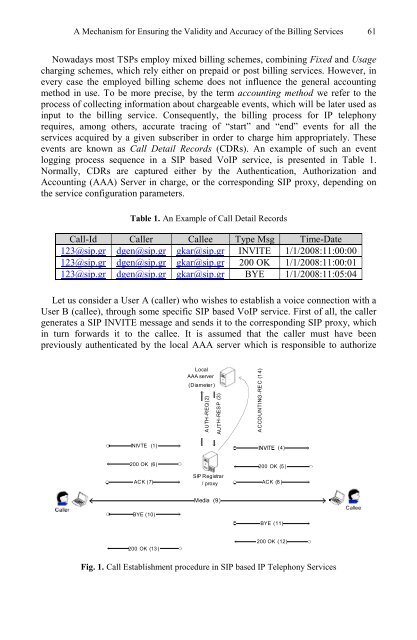Lecture Notes in Computer Science 5185
Lecture Notes in Computer Science 5185
Lecture Notes in Computer Science 5185
Create successful ePaper yourself
Turn your PDF publications into a flip-book with our unique Google optimized e-Paper software.
A Mechanism for Ensur<strong>in</strong>g the Validity and Accuracy of the Bill<strong>in</strong>g Services 61<br />
Nowadays most TSPs employ mixed bill<strong>in</strong>g schemes, comb<strong>in</strong><strong>in</strong>g Fixed and Usage<br />
charg<strong>in</strong>g schemes, which rely either on prepaid or post bill<strong>in</strong>g services. However, <strong>in</strong><br />
every case the employed bill<strong>in</strong>g scheme does not <strong>in</strong>fluence the general account<strong>in</strong>g<br />
method <strong>in</strong> use. To be more precise, by the term account<strong>in</strong>g method we refer to the<br />
process of collect<strong>in</strong>g <strong>in</strong>formation about chargeable events, which will be later used as<br />
<strong>in</strong>put to the bill<strong>in</strong>g service. Consequently, the bill<strong>in</strong>g process for IP telephony<br />
requires, among others, accurate trac<strong>in</strong>g of “start” and “end” events for all the<br />
services acquired by a given subscriber <strong>in</strong> order to charge him appropriately. These<br />
events are known as Call Detail Records (CDRs). An example of such an event<br />
logg<strong>in</strong>g process sequence <strong>in</strong> a SIP based VoIP service, is presented <strong>in</strong> Table 1.<br />
Normally, CDRs are captured either by the Authentication, Authorization and<br />
Account<strong>in</strong>g (AAA) Server <strong>in</strong> charge, or the correspond<strong>in</strong>g SIP proxy, depend<strong>in</strong>g on<br />
the service configuration parameters.<br />
Table 1. An Example of Call Detail Records<br />
Call-Id Caller Callee Type Msg Time-Date<br />
123@sip.gr dgen@sip.gr gkar@sip.gr INVITE 1/1/2008:11:00:00<br />
123@sip.gr dgen@sip.gr gkar@sip.gr 200 OK 1/1/2008:11:00:01<br />
123@sip.gr dgen@sip.gr gkar@sip.gr BYE 1/1/2008:11:05:04<br />
Let us consider a User A (caller) who wishes to establish a voice connection with a<br />
User B (callee), through some specific SIP based VoIP service. First of all, the caller<br />
generates a SIP INVITE message and sends it to the correspond<strong>in</strong>g SIP proxy, which<br />
<strong>in</strong> turn forwards it to the callee. It is assumed that the caller must have been<br />
previously authenticated by the local AAA server which is responsible to authorize<br />
Fig. 1. Call Establishment procedure <strong>in</strong> SIP based IP Telephony Services

















